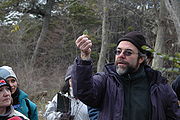
Omora Ethnobotanical Park
Encyclopedia
Omora Ethnobotanical Park is a protected area of Chile
located 4 km (2 mi) west of Puerto Williams
on Navarino Island in the extreme southern Magellan and Chilean Antarctica Region. The Omora Park is a research, education and conservation center for the Cape Horn Biosphere Reserve
. The park itself includes a representative variety subantarctic
flora
open to the public for formal and information education. Within its boundaries, one can find deciduous forests (Nothofagus antarctica and Nothofagus pumilio) and evergreen broadleaf forests (Nothofagus betuloides), as well as bogs and high-Andean ecosystems and diverse mosses, lichens and liverworts (termed the "Miniature Forests of Cape Horn" by Omora Park scientists).
Founding director Dr Ricardo Rozzi
inaugurated the practice of "field environmental philosophy" at the Omora Park. Since its creation in 2000, the Omora Park and its partners and colleagues have gone on to lead a transdisciplinary biocultural conservation initiative that led to the creation of the Cape Horn Biosphere Reserve
. A consortium of institutions now support this program including the Institute of Ecology and Biodiversity and the University of Magallanes in Chile and the University of North Texas
, the Center for Environmental Philosophy and the Omora Sub-Antarctic Research Alliance in the United States.
One example of the way the Omora Park attempts to link theory and practice can be found in the Tourism with a Hand Lens
initiative. In 2008, the Omora Park received the "Science and Practice of Ecology and Society Award", given by the Foundation for Scientific Synthesis.

Protected areas of Chile
The protected areas of Chile are areas that have natural beauty or significant historical value protected by the government of Chile. These protected areas cover over , which is 19% of the territory of Chile...
located 4 km (2 mi) west of Puerto Williams
Puerto Williams
Puerto Williams is a Chilean port, located on Isla Navarino facing the Beagle Channel. It is the capital of the Chilean Antarctic Province, one of four provinces located in the Magellan and Chilean Antartica Region...
on Navarino Island in the extreme southern Magellan and Chilean Antarctica Region. The Omora Park is a research, education and conservation center for the Cape Horn Biosphere Reserve
Cape Horn Biosphere Reserve
The Cape Horn Biosphere Reserve is located in the extreme south of Chile and comprises marine areas, islands, fjords, channels, forests and moorland. It covers an area of approximately 49,000 km²...
. The park itself includes a representative variety subantarctic
Subantarctic
The Subantarctic is a region in the southern hemisphere, located immediately north of the Antarctic region. This translates roughly to a latitude of between 46° – 60° south of the Equator. The subantarctic region includes many islands in the southern parts of the Indian Ocean, Atlantic Ocean and...
flora
Flora
Flora is the plant life occurring in a particular region or time, generally the naturally occurring or indigenous—native plant life. The corresponding term for animals is fauna.-Etymology:...
open to the public for formal and information education. Within its boundaries, one can find deciduous forests (Nothofagus antarctica and Nothofagus pumilio) and evergreen broadleaf forests (Nothofagus betuloides), as well as bogs and high-Andean ecosystems and diverse mosses, lichens and liverworts (termed the "Miniature Forests of Cape Horn" by Omora Park scientists).
Founding director Dr Ricardo Rozzi
Ricardo Rozzi
Ricardo Rozzi is a Chilean ecologist and philosopher who teaches at the University of North Texas and the Universidad de Magallanes...
inaugurated the practice of "field environmental philosophy" at the Omora Park. Since its creation in 2000, the Omora Park and its partners and colleagues have gone on to lead a transdisciplinary biocultural conservation initiative that led to the creation of the Cape Horn Biosphere Reserve
Cape Horn Biosphere Reserve
The Cape Horn Biosphere Reserve is located in the extreme south of Chile and comprises marine areas, islands, fjords, channels, forests and moorland. It covers an area of approximately 49,000 km²...
. A consortium of institutions now support this program including the Institute of Ecology and Biodiversity and the University of Magallanes in Chile and the University of North Texas
University of North Texas
The University of North Texas is a public institution of higher education and research in Denton. Founded in 1890, UNT is part of the University of North Texas System. As of the fall of 2010, the University of North Texas, Denton campus, had a certified enrollment of 36,067...
, the Center for Environmental Philosophy and the Omora Sub-Antarctic Research Alliance in the United States.
One example of the way the Omora Park attempts to link theory and practice can be found in the Tourism with a Hand Lens
Tourism with a Hand Lens
"Tourism with a Hand Lens" is a term coined by Dr. Ricardo Rozzi and his colleagues to refer to a new speciality tourism being promoted in the Cape Horn Biosphere Reserve...
initiative. In 2008, the Omora Park received the "Science and Practice of Ecology and Society Award", given by the Foundation for Scientific Synthesis.
External links

- Omora Foundation
- OSARA (Omora Subantarctic Research Alliance)
- Center for Environmental Philosophy
- Institute of Ecology and Biodiversity, Chile (IEB)
- UNT Chile Program Office
- Omora Biocultural Conservation Approach: Ecology & Society 2006
- Field environmental philosophy and biocultural conservation at the Omora Ethnobotanical Park: Methodological approaches to broaden the ways of integrating the social component(“S”) in Long-Term Socio-Ecological Research (LTSER) Sites
- Belleza de Pensar Cristian Warnken, Lorenzo Aillapán y Ricardo Rozzi
- La Medida de Omora Claudia Esslinger
- Efecto Picaflor
- Efecto Picaflor sinopsis
- TV UMAG Omora LA BIODIVERSIDAD
- TV UMAG Omora VALOR INTRINSECO
- TV UMAG Omora VALOR INSTRUMENTAL

